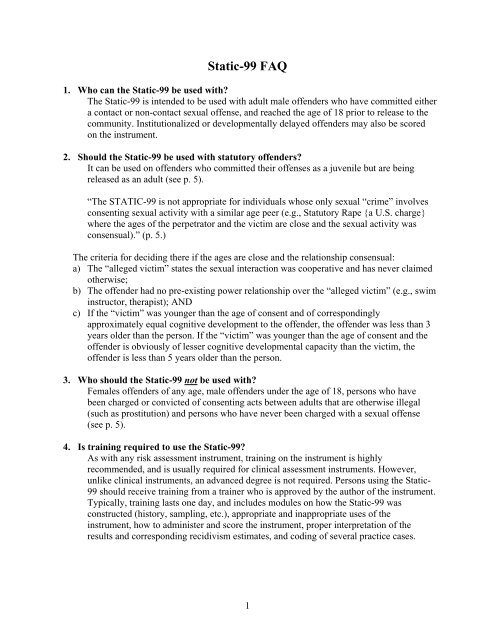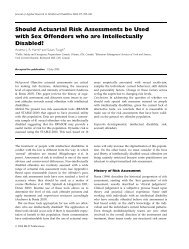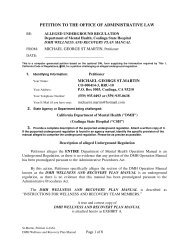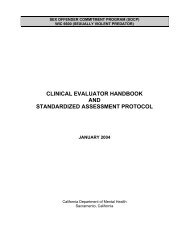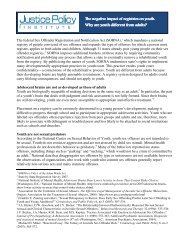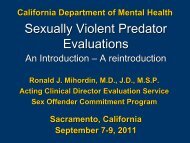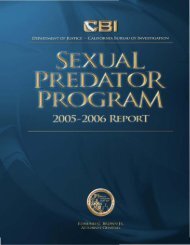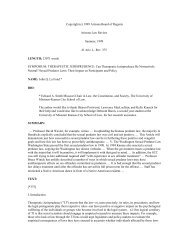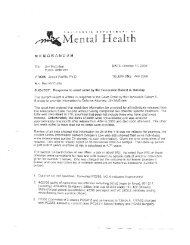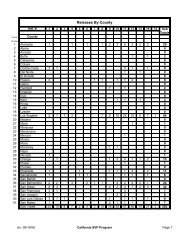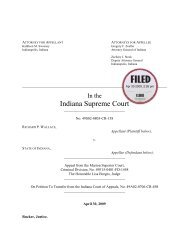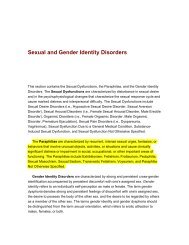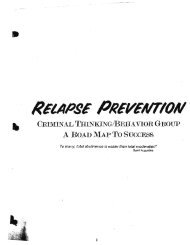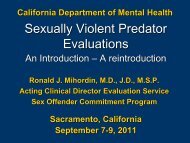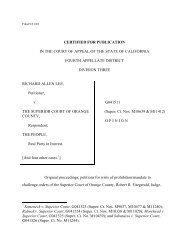Static-99 FAQ - Defense for SVP
Static-99 FAQ - Defense for SVP
Static-99 FAQ - Defense for SVP
You also want an ePaper? Increase the reach of your titles
YUMPU automatically turns print PDFs into web optimized ePapers that Google loves.
<strong>Static</strong>-<strong>99</strong> <strong>FAQ</strong><br />
1. Who can the <strong>Static</strong>-<strong>99</strong> be used with<br />
The <strong>Static</strong>-<strong>99</strong> is intended to be used with adult male offenders who have committed either<br />
a contact or non-contact sexual offense, and reached the age of 18 prior to release to the<br />
community. Institutionalized or developmentally delayed offenders may also be scored<br />
on the instrument.<br />
2. Should the <strong>Static</strong>-<strong>99</strong> be used with statutory offenders<br />
It can be used on offenders who committed their offenses as a juvenile but are being<br />
released as an adult (see p. 5).<br />
“The STATIC-<strong>99</strong> is not appropriate <strong>for</strong> individuals whose only sexual “crime” involves<br />
consenting sexual activity with a similar age peer (e.g., Statutory Rape {a U.S. charge}<br />
where the ages of the perpetrator and the victim are close and the sexual activity was<br />
consensual).” (p. 5.)<br />
The criteria <strong>for</strong> deciding there if the ages are close and the relationship consensual:<br />
a) The “alleged victim” states the sexual interaction was cooperative and has never claimed<br />
otherwise;<br />
b) The offender had no pre-existing power relationship over the “alleged victim” (e.g., swim<br />
instructor, therapist); AND<br />
c) If the “victim” was younger than the age of consent and of correspondingly<br />
approximately equal cognitive development to the offender, the offender was less than 3<br />
years older than the person. If the “victim” was younger than the age of consent and the<br />
offender is obviously of lesser cognitive developmental capacity than the victim, the<br />
offender is less than 5 years older than the person.<br />
3. Who should the <strong>Static</strong>-<strong>99</strong> not be used with<br />
Females offenders of any age, male offenders under the age of 18, persons who have<br />
been charged or convicted of consenting acts between adults that are otherwise illegal<br />
(such as prostitution) and persons who have never been charged with a sexual offense<br />
(see p. 5).<br />
4. Is training required to use the <strong>Static</strong>-<strong>99</strong><br />
As with any risk assessment instrument, training on the instrument is highly<br />
recommended, and is usually required <strong>for</strong> clinical assessment instruments. However,<br />
unlike clinical instruments, an advanced degree is not required. Persons using the <strong>Static</strong>-<br />
<strong>99</strong> should receive training from a trainer who is approved by the author of the instrument.<br />
Typically, training lasts one day, and includes modules on how the <strong>Static</strong>-<strong>99</strong> was<br />
constructed (history, sampling, etc.), appropriate and inappropriate uses of the<br />
instrument, how to administer and score the instrument, proper interpretation of the<br />
results and corresponding recidivism estimates, and coding of several practice cases.<br />
1
5. What in<strong>for</strong>mation is needed to score the <strong>Static</strong>-<strong>99</strong><br />
According to the rules, an official criminal history record is required to score the<br />
instrument (p. 11), and self-report is acceptable only under extremely limited<br />
circumstances (p. 4). Thus, only persons with access to the necessary criminal history<br />
in<strong>for</strong>mation should be scoring the <strong>Static</strong>-<strong>99</strong>. It is acceptable to rescore the <strong>Static</strong>-<strong>99</strong> when<br />
it is received from a secondary source and/or more in<strong>for</strong>mation becomes available.<br />
6. Can I score the <strong>Static</strong>-<strong>99</strong> with missing data<br />
The only item that can be omitted from the instrument is #2 Ever Lived With. The item<br />
should be scored as a zero (p. 4). Other sources should be consulted when in<strong>for</strong>mation is<br />
missing or suspect.<br />
7. What is the <strong>Static</strong>-2002 and does it differ from the <strong>Static</strong>-<strong>99</strong><br />
The <strong>Static</strong>-2002 represents a conceptual overhaul to the <strong>Static</strong>-<strong>99</strong> where two items were<br />
dropped, six were added, and questions now represent five scales: age, persistence of<br />
sexual offending, deviant sexual interests, relationship to victims, and general criminality.<br />
The items removed were “#2 Ever Lived With” and “#3 Index Non-Sexual Violence –<br />
Any Convictions”. Additional training is recommended <strong>for</strong> agencies that would like to<br />
implement the <strong>Static</strong>-2002.<br />
8. What is the RRASOR and how does it differ from the <strong>Static</strong>-<strong>99</strong> Should I use it<br />
instead of the <strong>Static</strong>-<strong>99</strong><br />
The RRASOR, or Rapid Risk Assessment <strong>for</strong> Sexual Offense Recidivism is a pre-cursor<br />
to the <strong>Static</strong>-<strong>99</strong>; which was created by merging the SACJ-Min from the UK with the<br />
RRASOR from Canada. The four items culled from the RRASOR are: age at release,<br />
prior sexual offenses, extrafamilial victims, and male victims. The authors recommend<br />
using the <strong>Static</strong>-<strong>99</strong> in place of the RRASOR because the <strong>Static</strong>-<strong>99</strong> includes more<br />
in<strong>for</strong>mation and has been more extensively cross-validated.<br />
9. Where can I get practice cases<br />
There is a self-quiz in the coding manual (Appendix Two, p. 61), and the New York State<br />
Office of Sex Offender Management has created a two-part quiz. The first part covers<br />
basic concepts of the <strong>Static</strong>-<strong>99</strong>, and the second includes examples <strong>for</strong> each of the ten<br />
questions. These are available at www.static<strong>99</strong>.org, click on “Training”.<br />
10. When implementing the <strong>Static</strong>-<strong>99</strong> <strong>for</strong> the first time in a community correction setting,<br />
how old can the index offense be be<strong>for</strong>e I should not use the <strong>Static</strong>-<strong>99</strong><br />
It is possible to use the <strong>Static</strong>-<strong>99</strong> <strong>for</strong> sexual offenders who were released into the<br />
community following an index sexual offence during the past 10 years. For offenders<br />
who received a community sentence, the release date would be the date of sentencing.<br />
The recidivism rates <strong>for</strong> offenders with older release dates should be adjusted according<br />
to the time-free in the community (see Appendix 1, p. 59). Evaluators should note,<br />
however, that <strong>Static</strong>-<strong>99</strong> scores become increasingly hard to interpret the longer the time<br />
since the last release from a sexual offence.<br />
2
11. Should the risk estimates ever be adjusted <strong>for</strong> time free in the community Does that<br />
include time under community supervision such as probation or parole<br />
When an offender has been offense-free in the community, the adjusted recidivism<br />
estimates provided in Appendix One (p. 59) can be used. Please note that time free<br />
INCLUDES periods of community supervision. However, when an offender incurs a new<br />
arrest charge, the nature of the offense and charges must be examined to determine which<br />
risk estimates now apply to the offender.<br />
With strict supervision there are limited opportunities to reoffend, as such, those with this<br />
level of supervision should not get credit <strong>for</strong> not reoffending (e.g., benefit from a<br />
reduction in recidivism estimates). Typically, there is a bump in recidivism rates when<br />
strict supervision is reduced or ended completely. Also, <strong>for</strong> those who are relatively<br />
under-supervised and do not have a new arrest, credit should be given within the context<br />
of opportunities to reoffend (e.g., if the opportunity to reoffend has been limited, it may<br />
not be an indicator of desistence). Remaining offense free means “no new sexual or<br />
violent convictions, nor a non-violent conviction that would have resulted in more than<br />
minimal jail time (1-2 months).” (p. 59).<br />
Guidelines <strong>for</strong> interpretation of this rule in New York:<br />
A. A new misdemeanor and felony sexual or assaultive charges require use of the<br />
original recidivism estimates.<br />
B. Violations typically do not count as a new crime since they are only punishable by<br />
up to 15 days in jail. However, the nature of the offense should be considered<br />
(e.g. § PL 140.05 trespass is a violation, however, if one objectively knows that<br />
the trespassing behavior was sexual in nature the event should count and the coder<br />
use the original estimates).<br />
C. Failure to register is neither a sexual or assaultive offense, and thus the reduced<br />
estimates may be used in the event that there are no other sexual or assaultive<br />
offenses occurring while in the community.<br />
D. Coders need to use their judgment.<br />
12. What does a “departure” from the score mean Can I adjust the score<br />
<strong>Static</strong>-<strong>99</strong> scores cannot be adjusted, or overridden, without the corresponding recidivism<br />
estimates being voided. The <strong>Static</strong>-<strong>99</strong> is not intended to be a comprehensive risk<br />
assessment instrument, and as such, some factors related to risk are not included because<br />
they failed to predict recidivism in this particular model. However, that does not mean<br />
that those factors should not be considered in an overall assessment of risk.<br />
A “departure” refers to extenuating or acute risk factors that are not accounted <strong>for</strong> by the<br />
instrument that presently outweigh the level of risk arrived at via the actuarial<br />
assessment. For example, an acute risk would be someone who scores as low risk (0 or 1)<br />
but has stated an intention to reoffend. An empirically-based example would be an<br />
offender with a high risk score who has severe health issues and no access to potential<br />
victims. When the assessor feels that a departure is necessary, he or she should include<br />
the empirically-based or acute reasons in writing along with the assessment.<br />
3
13. How should NY penal and criminal procedure laws be interpreted when scoring the<br />
<strong>Static</strong>-<strong>99</strong><br />
The <strong>Static</strong>-<strong>99</strong> <strong>for</strong> the most part is a behaviorally-based instrument, with the exception of<br />
the items referring to non-sexual violence. This exception occurs <strong>for</strong> the items reflecting<br />
convictions <strong>for</strong> non-sexual violence where the name and/or language of the statute must<br />
indicate violence, such as assault (see pages 27-34). Thus, when determining whether an<br />
offense is sexual in nature, it is often necessary to examine the facts of the offense when<br />
the sexual intent is not clear from the charges and/or statutory language.<br />
14. Can the <strong>Static</strong>-<strong>99</strong> be scored on an offender who is charged with a non-sexual offense<br />
With the exception of the non-sexual violence questions, the nature of the sexual<br />
behavior is more important than the penal law section under which the offender was<br />
charged. For example, NY PL § 265.10 Endangering the Welfare of a Child can include<br />
sexual behavior that is not enumerated by the language of the statute, but would<br />
nevertheless be considered a sexual offense <strong>for</strong> the purposes of scoring the instrument. As<br />
long as the assessor can objectively argue that the offense was sexual in nature, the<br />
instrument can be scored.<br />
15. Can juvenile offenses be used to score the <strong>Static</strong>-<strong>99</strong> on criminal history questions<br />
Juvenile offenses should be included in the criminal history and victimization questions,<br />
even if the events are sealed. Under limited circumstances, sexually-based PINS petitions<br />
may count as well (see p. 18, 28, 32, 39, and 44).<br />
16. Do Youthful Offender (YO) adjudications count<br />
Yes. Youthful Offender adjudications (NY) count even though the nature of the offense is<br />
obscured from the public and replaced with a generic adjudication on the criminal history<br />
report. For assessment purposes, the behavior still occurred.<br />
17. What are the best practices in implementing the <strong>Static</strong>-<strong>99</strong><br />
a. All persons who will encounter or use the assessment results should be trained by<br />
a trainer who is approved by the developers of the instrument. For example, a<br />
probation officer who specializes in pre-sentence investigations should be trained<br />
as well as officers who will supervise the offender and have reason to use the<br />
<strong>Static</strong>-<strong>99</strong> score in a decision-making capacity.<br />
b. Supervisors should review and monitor coding skills of person who are scoring<br />
the instrument.<br />
c. To increase consistency in coding (reliability) it is ideal <strong>for</strong> assessment<br />
instruments to be scored by a group, or to hold regular sessions where coding<br />
issues can be discussed so that all persons scoring the instrument can benefit from<br />
the experience.<br />
d. Jurisdictions are encouraged to review their criminal procedure and penal laws<br />
and develop coding tables to assist assessors and increase inter-rater reliability.<br />
For example, see the New York Coding Tables short and long versions.<br />
4
18. How would I characterize the meaning of a score in a pre-sentence report or in<br />
court<br />
The score can be interpreted in terms of<br />
a. percentile ranks (how risky is this offender compared to other sexual offenders)<br />
and<br />
b. b) estimated recidivism rates <strong>for</strong> similar offenders. For the recidivism risk<br />
estimates, evaluators should be careful to mention that the estimates are group<br />
averages and the risk presented by the offender may be higher or lower depending<br />
on factors not measured by <strong>Static</strong>-<strong>99</strong>. An example of the wording in reports is<br />
provided in Appendix Severn (page 71).<br />
19. When considering whether a Parole Violation should count as a new index<br />
offense, is it important to determine whether violation charges were sustained or<br />
withdrawn<br />
According to the coding rules (pg 16), the minimum criteria <strong>for</strong> counting a parole<br />
violation is “arrest” (providing of course, that the behavior is more than a technical<br />
offense). Consequently, violation charges do not need to be sustained to count.<br />
20. I have heard that the original recidivism estimates are no longer valid, is this true<br />
In more recent samples, the sexual recidivism rates were lower than the rates observed in<br />
the original developmental samples. Dr. Hanson and colleagues are current collecting and<br />
analyzing data to create new norms. A detailed analysis of the changes in the recidivism<br />
rates was presented at the 27th Annual Research and Treatment Conference held by the<br />
Association <strong>for</strong> the Treatment of Sexual Abusers in Atlanta, Georgia, October 22-25 and<br />
is available on this website under “Presentations”. The revised tables are available under<br />
“<strong>Static</strong>-<strong>99</strong> Documents”.<br />
5


